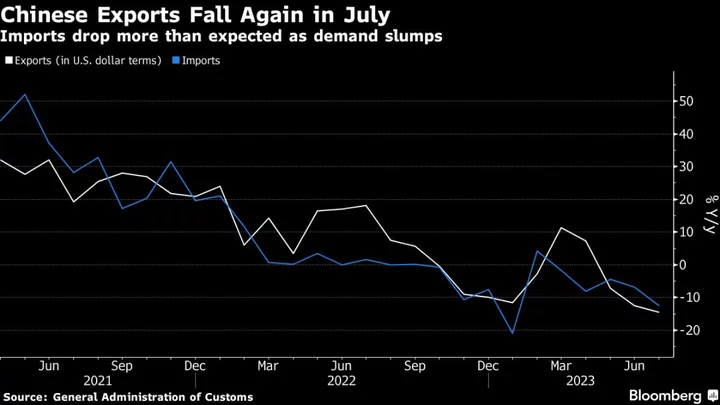China’s trade plunged in July as slowing global demand clouded the outlook for exports, while domestic pressures weighed on imports in a hit to the economic recovery.
Overseas shipments dropped 14.5% in dollar terms last month from a year earlier — the worst decline since February 2020 — while imports contracted 12.4%, the customs administration said Tuesday. That left a trade surplus of $80.6 billion for the month. The export and import figures were worse than what economists polled by Bloomberg had expected.
The deepened slump in imports “is a reflection of weak domestic demand,” said Zhang Zhiwei, chief economist at Pinpoint Asset Management Ltd. The drop was the worst since January. “The overall consumption and investment growth probably both stayed quite weak in China.”
China’s economic recovery this year was expected to be buoyed by strong domestic demand, but a housing market slump has hit construction while consumption growth is slowing — issues underlined by the fifth consecutive month of falling imports. Data due Wednesday is expected to show consumer prices declined in July, adding to evidence of that lack of demand.
Some economists also attributed the decline in imports to falling commodity prices — meaning that even though Chinese factories were still buying materials, they were doing so at lower prices. For example, the value of crude oil imports fell more than 12% in the first seven months of 2023 from a year ago, but by volume crude oil actually jumped by around 12% in that time.
Chinese stocks listed in Hong Kong led losses in Asia on Tuesday. The Hang Seng China Enterprises Index was down 1.8% as of 1:33 p.m. local time and the onshore CSI 300 Index was little changed. The offshore yuan was little moved after the data release, retaining its morning loss of 0.3%.
China’s central bank on Tuesday set the yuan fixing at the weakest level in almost a month — a move that signaled some tolerance of softness in the currency and which triggered yuan selloffs in the foreign exchange market. Allowing some fluctuation in the yuan’s value should benefit the economy, given a weaker currency can provide more support for exports, said Ken Cheung, chief Asia FX strategist at Mizuho Bank Ltd.
Demand Woes
Among the worst-hit regions due to China’s falling demand were South Korea, Japan, Taiwan, South Africa and Canada, which dropped by double-digit rates. That indicated subdued appetite for electronic products and minerals. Imports from the US fell 11.2%, while those from the EU were down 3%.
Exports, meanwhile, have been waning because of slowing demand overseas — making it impossible to maintain the record level of shipments seen in 2021 and 2022 during the pandemic.
Shipments to the US plummeted 23.1% in July, according to the customs data. Exports to other markets including Japan, South Korea, Taiwan, Asean, the EU, Brazil and Australia all dropped by double digit percentages, too.
Beijing has been looking for ways to stimulate growth this year, though the scope of support so far has been targeted and limited. Authorities have announced some policies to boost demand for houses, electric cars, and other products.
Last month, several departments outlined a plan to encourage more household spending on everything from electric appliances to furniture. Three agencies later detailed measures to increase manufacturing of small consumer goods — or the so-called light industry sector, which makes up more than a quarter of China’s exports.
What Bloomberg Economics Says...
“Deeper contractions in China’s exports and imports in July show the economy is under intensifying pressure on both the external and domestic fronts.
“The government’s pro-growth pledges are encouraging. But without powerful follow-through that turns plans into action, weakness in the second half could sink prospects for achieving this year’s 5% growth target.”
Eric Zhu, economist
See here for the full report.
Policy loosening on property and credit will help the economy in the second half, said Larry Hu, head of China economics at Macquarie Group Ltd.
“Destocking — which was evident given the falling PPI numbers in the past quarter — should taper off and even some restocking may take place in the coming months,” he said. “We expect economic growth to improve in the second half of the year, and that should give some boost to imports.”
Some positive signs have already emerged, according to Xing Zhaopeng, senior China strategist at Australia & New Zealand Banking Group Ltd. China’s purchases of soy beans, coal and crude oil by volume jumped by double-digit rates in July, though he estimated that imports of iron ore and copper grew within a more modest range.
“Construction activities remain weak, but industrial activities may see a rebound in July,” he said. More data for the month including industrial production figures are due next week.
“Since the low base effect disappeared in July, these numbers look very good.”
--With assistance from Fran Wang, Yujing Liu, Wenjin Lv, Shikhar Balwani and Qizi Sun.
(Updates throughout.)









